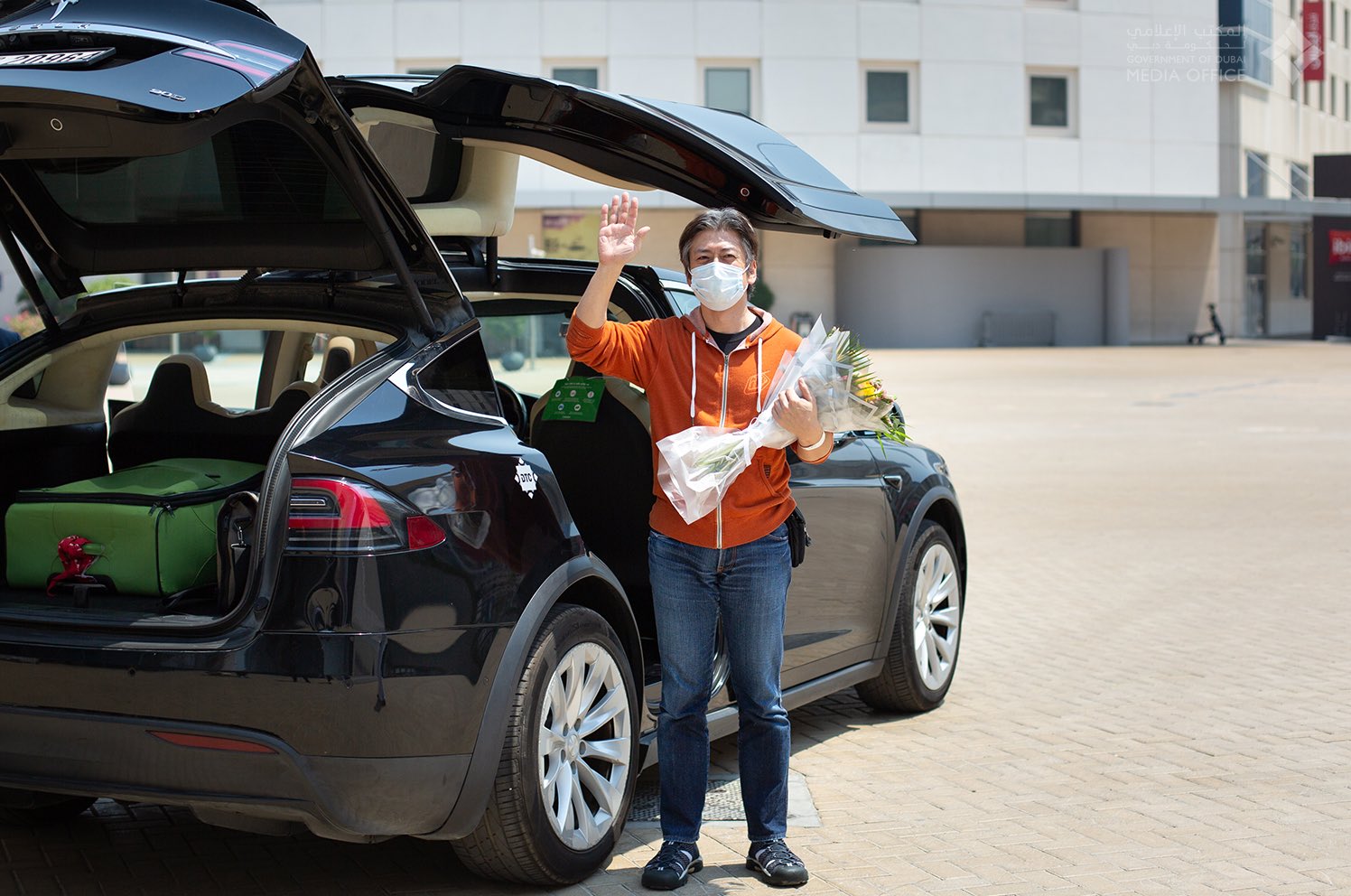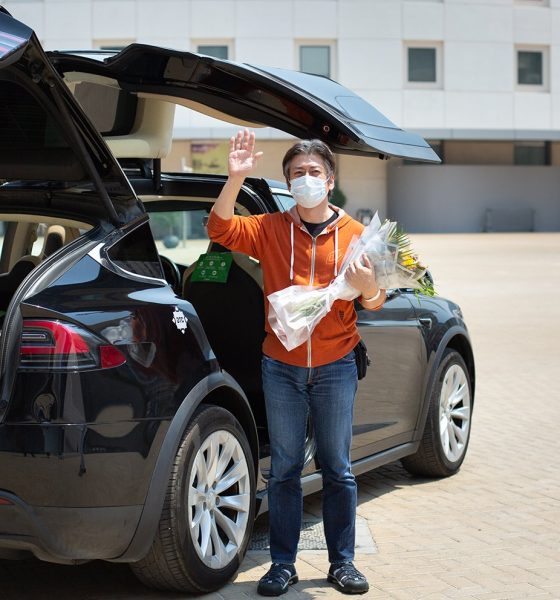

News
Tesla Model X transports final COVID-19 patient from Dubai hospital
A Tesla Model X transported the final COVID-19 patient from the Dubai Field Hospital in the United Arab Emirates on June 7.
Hiroaki Fujita, a Japanese man who was diagnosed with the novel coronavirus earlier this year, left the makeshift hospital in Dubai on July 7 after defeating the virus. After making his way down the hallway of the medical facility, Fujita was greeted by doctors and nurses. The medical staff applauded the patient’s strength as he had fully recovered from the illness that has taken the lives of over 540,000 people across the world.
The medical staff who attended to Fujita since his contraction of the coronavirus were still wearing protective equipment like facemasks, bidding farewell to the final patient who resided at the hospital because of the deadly illness.
When Fujita left the hospital, a Tesla Model X had its Falcon Wing doors opened, ready to transport the man to his next destination.
#Dubai field hospital bids farewell to the last coronavirus patient.@DHA_Dubai @DXBMediaOffice pic.twitter.com/ywV4ppJe94
— حسن سجواني 🇦🇪 Hassan Sajwani (@HSajwanization) July 7, 2020
In a brief interview with the AFP News Agency, Fujita said, “I ask everyone to take a more safer way. Feeling very good that I am about to go out.”
Symbolically, a Tesla electric vehicle transported the final COVID-19 infected patient from the hospital.
When the COVID-19 pandemic swooped through the United States in March and April, Tesla CEO Elon Musk offered a helping hand by providing extra FDA-approved ventilators to any hospital that would need them immediately.
“Will ship to hospitals worldwide within Tesla delivery regions. Device & shipping cost are free. Only requirement is that the vents are needed immediately for patients, not stored in a warehouse. Please [let] me or @Tesla know,” Musk tweeted on March 31.
Tesla then began developing in-house ventilators using parts from its electric vehicles. The company also offered its Giga New York solar production plant in Buffalo, NY, to Medtronic, a medical supply company.
According to WorldOMeters.info, the United Arab Emirates has been affected by 52,068 confirmed cases of the COVID-19 virus. 40,721 infected patients have recovered, and 324 people have unfortunately passed away due to the illness.
To treat those infected by the virus, the City of Dubai opened the Field Hospital inside of its World Trade Centre on Saturday, April 18, LiveMint reported. The 3,000-bed capacity hospital was put together to prepare for a potential surge in coronavirus cases within Dubai.
Although the hospital is now empty, Manal Taryam, the facility’s director, stated that medical equipment would be left at the site and continuously sterilized in case another outbreak occurs.
“If we need, we can reactivate the field hospital within hours. But, we are confident while closing it,” Taryam added. “Today, thanks to efforts, we have been able to put the pandemic under control.”
Watch Hiroaki Fujita leave the Dubai Field Hospital after defeating the COVID-19 pandemic below.
#DubaiFieldHospital bids farewell to the last coronavirus patient. pic.twitter.com/IbZgFeCBBU
— هيئة الصحة بدبي (@DHA_Dubai) July 7, 2020

Elon Musk
Elon Musk confirms xAI’s purchase of five 380 MW natural gas turbines
The deal, which was confirmed by Musk on X, highlights xAI’s effort to aggressively scale its operations.

xAI, Elon Musk’s artificial intelligence startup, has purchased five additional 380 MW natural gas turbines from South Korea’s Doosan Enerbility to power its growing supercomputer clusters.
The deal, which was confirmed by Musk on X, highlights xAI’s effort to aggressively scale its operations.
xAI’s turbine deal details
News of xAI’s new turbines was shared on social media platform X, with user @SemiAnalysis_ stating that the turbines were produced by South Korea’s Doosan Enerbility. As noted in an Asian Business Daily report, Doosan Enerbility announced last October that it signed a contract to supply two 380 MW gas turbines for a major U.S. tech company. Doosan later noted in December that it secured an order for three more 380 MW gas turbines.
As per the X user, the gas turbines would power an additional 600,000+ GB200 NVL72 equivalent size cluster. This should make xAI’s facilities among the largest in the world. In a reply, Elon Musk confirmed that xAI did purchase the turbines. “True,” Musk wrote in a post on X.
xAI’s ambitions
Recent reports have indicated that xAI closed an upsized $20 billion Series E funding round, exceeding the initial $15 billion target to fuel rapid infrastructure scaling and AI product development. The funding, as per the AI startup, “will accelerate our world-leading infrastructure buildout, enable the rapid development and deployment of transformative AI products.”
The company also teased the rollout of its upcoming frontier AI model. “Looking ahead, Grok 5 is currently in training, and we are focused on launching innovative new consumer and enterprise products that harness the power of Grok, Colossus, and 𝕏 to transform how we live, work, and play,” xAI wrote in a post on its website.
Elon Musk
Elon Musk’s xAI closes upsized $20B Series E funding round
xAI announced the investment round in a post on its official website.

xAI has closed an upsized $20 billion Series E funding round, exceeding the initial $15 billion target to fuel rapid infrastructure scaling and AI product development.
xAI announced the investment round in a post on its official website.
A $20 billion Series E round
As noted by the artificial intelligence startup in its post, the Series E funding round attracted a diverse group of investors, including Valor Equity Partners, Stepstone Group, Fidelity Management & Research Company, Qatar Investment Authority, MGX, and Baron Capital Group, among others.
Strategic partners NVIDIA and Cisco Investments also continued support for building the world’s largest GPU clusters.
As xAI stated, “This financing will accelerate our world-leading infrastructure buildout, enable the rapid development and deployment of transformative AI products reaching billions of users, and fuel groundbreaking research advancing xAI’s core mission: Understanding the Universe.”
xAI’s core mission
Th Series E funding builds on xAI’s previous rounds, powering Grok advancements and massive compute expansions like the Memphis supercluster. The upsized demand reflects growing recognition of xAI’s potential in frontier AI.
xAI also highlighted several of its breakthroughs in 2025, from the buildout of Colossus I and II, which ended with over 1 million H100 GPU equivalents, and the rollout of the Grok 4 Series, Grok Voice, and Grok Imagine, among others. The company also confirmed that work is already underway to train the flagship large language model’s next iteration, Grok 5.
“Looking ahead, Grok 5 is currently in training, and we are focused on launching innovative new consumer and enterprise products that harness the power of Grok, Colossus, and 𝕏 to transform how we live, work, and play,” xAI wrote.
Investor's Corner
Tesla gets price target bump, citing growing lead in self-driving

Tesla (NASDAQ: TSLA) stock received a price target update from Pierre Ferragu of Wall Street firm New Street Research, citing the company’s growing lead in self-driving and autonomy.
On Tuesday, Ferragu bumped his price target from $520 to $600, stating that the consensus from the Consumer Electronics Show in Las Vegas was that Tesla’s lead in autonomy has been sustained, is growing, and sits at a multiple-year lead over its competitors.
CES 2026 validates Tesla’s FSD strategy, but there’s a big lag for rivals: analyst
“The signal from Vegas is loud and clear,” the analyst writes. “The industry isn’t catching up to Tesla; it is actively validating Tesla’s strategy…just with a 12-year lag.”
The note shows that the company’s prowess in vehicle autonomy is being solidified by lagging competitors that claim to have the best method. The only problem is that Tesla’s Vision-based approach, which it adopted back in 2022 with the Model 3 and Model Y initially, has been proven to be more effective than competitors’ approach, which utilizes other technology, such as LiDAR and sensors.
Currently, Tesla shares are sitting at around $433, as the company’s stock price closed at $432.96 on Tuesday afternoon.
Ferragu’s consensus on Tesla shares echoes that of other Wall Street analysts who are bullish on the company’s stock and position within the AI, autonomy, and robotics sector.
Dan Ives of Wedbush wrote in a note in mid-December that he anticipates Tesla having a massive 2026, and could reach a $3 trillion valuation this year, especially with the “AI chapter” taking hold of the narrative at the company.
Ives also said that the big step in the right direction for Tesla will be initiating production of the Cybercab, as well as expanding on the Robotaxi program through the next 12 months:
“…as full-scale volume production begins with the autonomous and robotics roadmap…The company has started to test the all-important Cybercab in Austin over the past few weeks, which is an incremental step towards launching in 2026 with important volume production of Cybercabs starting in April/May, which remains the golden goose in unlocking TSLA’s AI valuation.”
Tesla analyst breaks down delivery report: ‘A step in the right direction’
Tesla has transitioned from an automaker to a full-fledged AI company, and its Robotaxi and Cybercab programs, fueled by the Full Self-Driving suite, are leading the charge moving forward. In 2026, there are major goals the company has outlined. The first is removing Safety Drivers from vehicles in Austin, Texas, one of the areas where it operates a ride-hailing service within the U.S.
Ultimately, Tesla will aim to launch a Level 5 autonomy suite to the public in the coming years.








